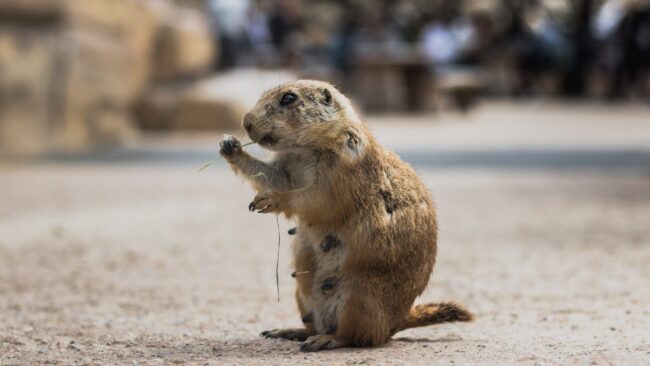Table of Contents
Remember those cute little, cuddly-looking groundhogs from Groundhog Day? Well, that’s not how most lawn owners see these stocky rodents. However endearing they may appear in their on-screen, animated versions, in reality, they usually give vegetable gardeners a destructive do-over.
Being some of the most energetic burrowers out there, groundhogs can single-handedly wreck your prize lawn and flower beds if you are not careful.
The numerous holes and tunnels are hazardous and contribute to ground instability but they can also damage underground water systems and drive up repair costs. For homeowners in North America, it’s critically important to know more about these animals and how to combat their destructive behaviors.
A Closer Look at Groundhogs
Let us first get to know these seemingly-harmless furry little creatures. Are you confused about what groundhogs are and how destructive they really are?
Also called woodchucks or whistle pigs, the groundhog is the largest member of the squirrel family. They have strong, stubby legs, and grizzled, gray-brown fur. Their ears are small and they have a short, bushy tails. They also have sharp, curved claws and their chisel-like teeth never stop growing.
Usually found in open fields or meadows close to wooded areas, they have also expanded their territory into domestic lawns and backyards.
They thrive on a varied, plant-based diet, eating everything from carrots, apples, and garden veggies to flowers, dandelions, and even tree bark. These binge-eaters consume about 1 lb to 1.5 lb of vegetables daily, meaning they can even out your vegetable patch in no time!
Fortunately for you, they hibernate from October to spring. From spring to fall, however, they remain active, especially early during the day, to stock up on the calories they need for hibernation.
Their Burrowing Behavior
One thing to know about them is that they burrow a lot. So much so that they have even been credited with excavating archaeological finds in Ohio!
Being extensive burrowers, they use their claws to dig out multi-chambered, complex underground tunnels. These can stretch beyond 25 feet under the ground, having 2-3 entrances with 10-inch wide openings. This is what makes them a menace to domestic properties.
Thankfully, groundhogs have been around for a while and over the years, people have come up with plenty of ways to keep them at bay. Let’s cover some of the most effective techniques you can use.
Don’t Attract Them
The first thing to note when trying to keep the woodchucks away is not to unwittingly lure them to your garden. Make sure your place doesn’t look like the perfect, attractive haven to these land beavers.
One way to do this is to clear away groundhog favorites like beans, peas, and melons – until you get your garden secured. Since they seek places with cover, clean away any piles of debris or wood that you might have stacked on your lawn. Also, trim any plants that may serve as cover.
The Ultimate Repellents
If you have spotted a groundhog problem in your garden, first make sure that you are dealing with groundhogs and not another rodent. Some rodent species have similar dietary habits and one can be mistaken for the other.
With easy-to-notice burrow openings, your garden would suffer conspicuous damage from the work of a groundhog.
Once it has been established that it is indeed the handiwork of a groundhog, we can move on to useful solutions. There is nothing like a pungent, stinky smell to drive away a rodent, especially groundhogs. The scent of garlic, castor oil, cayenne pepper, and lavender are things that the woodchuck just can’t stand. Sprinkling these around their burrow holes or filling them in the tunnels is sure to send them packing in no time.
Considering their fear of humans and predators like coyotes, wolves, foxes, and bobcats, scattering their hair around their burrows can also scare them away.
Plug Those Holes
Having successfully chased away the woodchucks, it is now time to fill those burrows and tunnels to keep them from being used again. This can be done by simply stuffing those underground dens with ‘Tunnel Fill’ or a mixture of gravel and soil.
To make the solution durable, it might be better to fill the holes with some of those pungent smells before sealing them shut. Adding substances like ammonia and castor oil to the filling mixture can make it more effective.
Castor oil, which is easily available in most homes, has long been a potent natural repellent. It even features on the Minnesota Department of Natural Resources list as a proven efficacious method of groundhog control.
Burying a panel of welded wire over the filled entrance hole can also prevent abandoned dens from being rediscovered.
How to Keep Groundhogs Away
Driving them away once doesn’t secure you from being troubled again. You need to devise more durable solutions to protect your garden from groundhogs and other rodents.
The use of fencing wire is a simple, popular, long-term deterrent. Planting lavender or garlic can also ward off any rodents looking to move back into your yard.
Final Words
Although the problem may seem to be cut out for a professional, with these tried and tested natural remedies and some patience, it is nothing you can’t take care of yourself.


